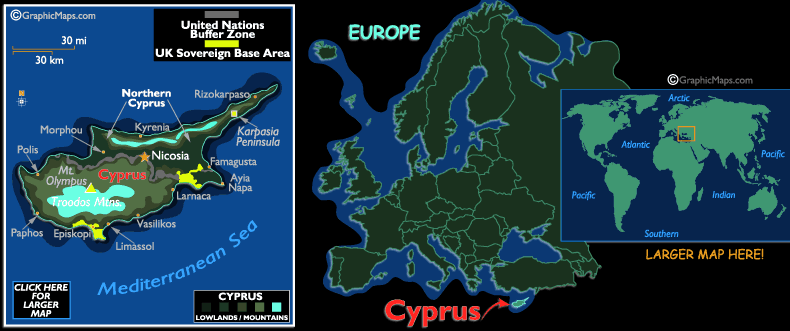
BANKNOTES OF CYPRUS
These notes are available for your viewing pleasure!
Click on the thumbnails to enlarge.

BANKNOTES OF CYPRUS
These notes are available for your viewing
pleasure!
Click on the thumbnails to enlarge.
The history of the Cypriot Pound
The Cypriot Pound also called the lira unofficially
is the currency used on the British portion of Cyprus. In the Turkish portion of
Cyprus the Turkish Lira is used. The Cypriot pound in commonly expressed as Ł,
CyŁ or CŁ and the ISO 4217 code is CYP.
The Cyprus pound, first introduced in 1879 was equal to one British pound
sterling up until 1960. The Cypriot pound was originally divided into 20
shillings like the British pound, but unlike the British shilling which was
divided into twelve pence, the Cypriot shilling was divided into 9 piastres or
kurus. This division established a link to the former currency of Cyprus
the Turkish Lira divisible by 100 kurus.
The value of the Cyprus pound in 1879 in
short:
GBP1 = CYŁ1
CyŁ1 = 20 shillings = 180 piastres
1 shilling = 9 piasters
1 Turkish Lira = 100 kurus = CyŁ-/11/1 (11 Cyprus shillings and 1 piastre)
In 1955 Cyprus chose to decimalize its'
currency for easier calculations, as well as the link to the Turkish Lira was no
longer in effect as the value of the Turkish Lira had declined. Cyprus chose to
divide the pound into 1000 mils. The pound's sub-unit was again changed, since
1983 the pound has been divided into 100 cents. Coins valued in mils are no
longer legal tender.
Coins in current use come in the denominations of 1,2,5,10,20 and 50 cents.
Notes in current use which are pictured above come in denominations of CyŁ1,
CyŁ5, CyŁ10 and CyŁ20. Banknotes have both Turkish and Greek on the front
and English on the back. All notes are currently issued by the Central
Bank of Cyprus.
Cyprus plans to replace its' currency with the euro at the beginning of 2008.
The Cypriot pound is currently pegged to the euro at CyŁ0.585274 +/- 15%.
BACK TO HOMEPAGE
Page created: 20 June 2006
Last Update: 20 June 2006
Maps are provided by Graphic Maps
All maps provided by them bear their copyright information.
All scans shown here are of actual notes from my collection unless otherwise
noted.
Images and content unless otherwise noted are copyrighted.
(c) 2006 Will's Online World Paper Money Gallery